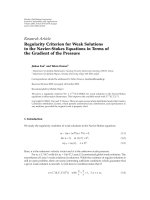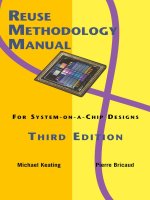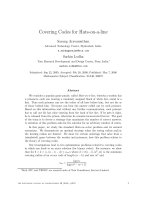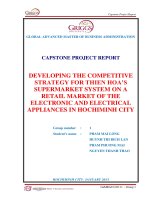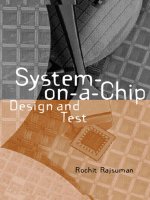(Kluwer) reuse methodology manual for system on a chip designs (3rd ed )
Bạn đang xem bản rút gọn của tài liệu. Xem và tải ngay bản đầy đủ của tài liệu tại đây (6.42 MB, 312 trang )
REUSE METHODOLOGY MANUAL
FOR SYSTEM -ON-A-CHIP DESIGNS
THIRD EDITION
Trademark Information
Synopsys and DesignWare are a registered trademarks of Synopsys, Inc.
Design Compiler is a trademark of Synopsys, Inc.
All other trademarks are the exclusive property of their respective holders and should
be treated as such.
REUSE METHODOLOGY MANUAL
FOR SYSTEM -ON-A-CHIP DESIGNS
THIRD EDITION
By
Michael Keating
Synopsys, Inc.
Pierre Bricaud
Synopsys, Inc.
KLUWER ACADEMIC PUBLISHERS
NEW YORK, BOSTON, DORDRECHT, LONDON, MOSCOW
eBook ISBN: 0-306-47640-1
Print ISBN: 1-4020-7141-8
©2002 Kluwer Academic Publishers
New York, Boston, Dordrecht, London, Moscow
Print ©2002 Kluwer Academic Publishers
All rights reserved
No part of this eBook may be reproduced or transmitted in any form or by any means, electronic,
mechanical, recording, or otherwise, without written consent from the Publisher
Created in the United States of America
Visit Kluwer Online at:
and Kluwer's eBookstore at:
Dordrecht
Table of Contents
Foreword
Preface to the Third Edition
Acknowledgements
Introduction
Goals of This Manual
Assumptions
Definitions
Virtual Socket Interface Alliance
Design for Reuse: The Challenge
Design for Use
Design for Reuse
The Emerging Business Model for Reuse
The System-on-Chip Design Process
A Canonical SoC Design
System Design Flow
Waterfall vs. Spiral
Top-Down vs. Bottom-Up
Construct by Correction
Summary
2.2.1
2.2.2
2.2.3
2.2.4
2.1
2.2
1.2
1.3
1.2.1
1.2.2
1.1.1
1.1.2
1.1.3
1.1
xiii
xv
xvii
1
2
3
3
4
4
5
5
6
11
11
15
15
16
9
9
1
2
v
i
Reuse Methodology Manual
2.3
2.4
2.3.1
2.3.2
The Specification Problem
Specification Requirements
Types of Specifications
The System Design Process
3
System-Level Design Issues: Rules and Tools
3.1
The Standard Model
3.1.1
3.1.2
Soft IP vs. Hard IP
The Role of Full-Custom Design in Reuse
3.2
Design for Timing Closure: Logic Design Issues
3.2.1
3.2.2
3.2.3
3.2.4
3.2.5
Interfaces and Timing Closure
Synchronous vs. Asynchronous Design Style
Clocking
Reset
Timing Exceptions and Multicycle Paths
3.3
3.3.1
3.3.2
3.3.3
3.3.4
Design for Timing Closure: Physical Design Issues
Floorplanning
Synthesis Strategy and Timing Budgets
Hard Macros
Clock Distribution
3.4
3.5
Design for Verification: Verification Strategy
System Interconnect and On-Chip Buses
3.5.1
3.5.2
3.5.3
3.5.4
3.5.5
Basic Interface Issues
Tristate vs. Mux Buses
Synchronous Design of Buses
Summary
IP-to-IP Interfaces
3.6
3.7
Design for Bring-Up and Debug: On-Chip Debug Structures
Design for Low Power
3.7.1
3.7.2
3.7.3
3.7.4
Lowering the Supply Voltage
Reducing Capacitance and Switching Activity
Sizing and Other Synthesis Techniques
Summary
3.8
3.8.1
3.8.2
3.8.3
3.8.4
3.8.5
Design for Test: Manufacturing Test Strategies
System-Level Test Issues
Memory Test
Microprocessor Test
Other Macros
Logic BIST
17
17
18
19
23
23
25
27
28
28
33
35
36
37
38
38
39
39
40
40
42
43
47
47
47
48
51
52
53
54
56
57
57
57
58
58
59
59
Reuse Methodology Manual
vii
Prerequisites for Reuse
Libraries
Physical Design Rules
The Macro Design Process
Overview of IP Design
Characteristics of Good IP
Implementation and Verification IP
Overview of Design Process
Key Features
Planning and Specification
Functional Specification
Verification Specification
Packaging Specification
Development Plan
High-Level Models as Executable Specifications
Macro Design and Verification
Summary
Soft Macro Productization
Productization Process
Activities and Tools
RTL Coding Guidelines
Overview of the Coding Guidelines
Basic Coding Practices
General Naming Conventions
Naming Conventions for VITAL Support
State Variable Names
Include Informational Headers in Source Files
Use Comments
Keep Commands on Separate Lines
Line Length
Indentation
Do Not Use HDL Reserved Words
Port Ordering
Port Maps and Generic Maps
VHDL Entity, Architecture, and Configuration Sections
Use Functions
Use Loops and Arrays
Use Meaningful Labels
5.2.1
5.2.2
5.2.3
5.2.4
5.2.5
5.2.6
5.2.7
5.2.8
5.2.9
5.2.10
5.2.11
5.2.12
5.2.13
5.2.14
5.2.15
5.1
5.2
5
4.5.1
4.5.2
4.5
4.4
4.2
4.3
4.1
4.1.1
4.1.2
4.1.3
4.3.1
4.3.2
4.3.3
4.3.4
4.3.5
4.4.1
3.9
3.9.1
3.9.2
4
60
60
61
63
63
64
65
67
68
69
69
71
71
71
72
73
77
78
78
78
81
81
82
82
84
85
85
87
87
87
88
89
89
92
93
93
94
96
viii Reuse Methodology Manual
5.3
Coding for Portability
5.3.1
5.3.2
5.3.3
5.3.4
5.3.5
5.3.6
5.3.7
5.4
Use Only IEEE Standard Types (VHDL)
Do Not Use Hard-Coded Numeric Values
Packages (VHDL)
Constant Definition Files (Verilog)
Avoid Embedding Synthesis Commands
Use Technology-Independent Libraries
Coding For Translation
Guidelines for Clocks and Resets
5.4.1
5.4.2
5.4.3
5.4.4
5.4.5
5.4.6
5.4.7
5.4.8
5.4.9
Avoid Mixed Clock Edges
Avoid Clock Buffers
Avoid Gated Clocks
Avoid Internally Generated Clocks
Gated Clocks and Low-Power Designs
Avoid Internally Generated Resets
Reset Logic Function
Single-Bit Synchronizers
Multiple-Bit Synchronizers
5.5
Coding for Synthesis
5.5.1
5.5.2
5.5.3
5.5.4
5.5.5
5.5.6
5.5.7
5.5.8
5.5.9
5.5.10
5.5.11
5.5.12
Infer Registers
Avoid Latches
If you must use a latch
Avoid Combinational Feedback
Specify Complete Sensitivity Lists
Blocking and Nonblocking Assignments (Verilog)
Signal vs. Variable Assignments (VHDL)
Case Statements vs. if-then-else Statements
Coding Sequential Logic
Coding Critical Signals
Avoid Delay Times
Avoid full_case and parallel_case Pragmas
5.6
Partitioning for Synthesis
5.6.1
5.6.2
5.6.3
5.6.4
5.6.5
5.6.6
5.6.7
5.6.8
5.6.9
Register All Outputs
Locate Related Combinational Logic in a Single Module
Separate Modules That Have Different Design Goals
Asynchronous Logic
Arithmetic Operators: Merging Resources
Partitioning for Synthesis Runtime
Avoid Timing Exceptions
Eliminate Glue Logic at the Top Level.
Chip-Level Partitioning
97
97
98
98
98
99
99
100
101
102
103
103
104
105
106
107
108
108
108
109
110
113
113
114
117
119
120
122
124
124
124
125
125
126
127
128
128
130
130
133
134
Reuse Methodology Manual
5.7
5.8
Designing with Memories
Code Profiling
6.1
6.2
6
7
Macro Synthesis Guidelines
Overview of the Synthesis Problem
Macro Synthesis Strategy
6.2.1
6.2.2
6.2.3
6.2.4
6.2.5
6.2.6
6.2.7
6.2.8
6.2.9
Macro Timing Constraints
Subblock Timing Constraints
Synthesis in the Design Process
Subblock Synthesis Process
Macro Synthesis Process
Wire Load Models
Preserve Clock and Reset Networks
Code Checking Before Synthesis
Code Checking After Synthesis
ix
135
136
137
137
138
139
139
140
141
141
142
142
143
143
144
144
145
145
145
146
147
148
150
153
154
155
159
160
161
161
163
165
166
169
169
171
153
6.3
6.4
6.5
Physical Synthesis
6.3.1
6.3.2
6.3.3
RAM and Datapath Generators
Memory Design
Classical Synthesis
Physical Synthesis
Physical Synthesis Deliverables
6.4.1
6.4.2
6.4.3
RAM Generator Flow
Datapath Design
Coding Guidelines for Synthesis Scripts
Macro Verification Guidelines
7.1
7.2
7.3
7.4
7.5
Overview of Macro Verification
7.1.1
7.1.2
7.4.1
7.4.2
7.4.3
7.4.4
7.5.1
7.5.2
Verification Plan
Verification Strategy
Inspection as Verification
Adversarial Testing
Testbench Design
Transaction-Based Verification
Component-Based Verification
Automated Response Checking
Verification Suite Design
Design of Verification Components
Bus Functional Models
Monitors
7.5.3
7.5.4
7.6.1
7.6.2
7.6.3
7.6.4
7.6.5
7.6
7.7
8.1
8.2
8.1.1
8.1.2
8.2.1
8.2.2
8.2.3
8.2.4
8.2.5
8.2.6
8.2.7
8.2.8
8.2.9
8.3
8.4
8.5
8.6
9
8.4.1
8.4.2
8.5.1
8.5.2
8.5.3
8.5.4
8.5.5
9.1
9.1.1
Device Models
Verification Component Usage
Getting to 100%
Functional and Code Coverage
Prototyping
Limited Production
Property Checking
Code Coverage Analysis
Timing Verification
Reuse Methodology Manualx
171
172
172
172
172
173
173
174
177
179
180
181
181
181
182
183
184
185
186
187
187
188
190
190
190
193
194
194
199
200
201
204
204
207
207
208
Overview
Why and When to Use Hard Macros
Design Process for Hard vs. Soft Macros
Design Issues for Hard Macros
Full-Custom Design
Interface Design
Design For Test
Clock
Aspect Ratio
Porosity
Pin Placement and Layout
Power Distribution
Antenna Checking
The Hard Macro Design Process
Productization of Hard Macros
Physical Design
Verification
Model Development for Hard Macros
Functional Models
Timing Models
Power Models
Test Models
Physical Models
Porting Hard Macros
Macro Deployment: Packaging for Reuse
Delivering the Complete Product
Soft Macro Deliverables
Developing Hard Macros
179
8
Reuse Methodology Manual
xi
9.1.2
9.1.3
9.1.4
Hard Macro Deliverables
Software
The Design Archive
9.2
10
10.1
10.2
10.3
10.4
10.5
10.2.1
10.2.2
10.2.3
10.3.1
10.3.2
10.3.3
10.3.4
10.3.5
210
212
213
214
217
217
218
218
219
220
221
221
221
222
223
223
223
224
226
23
0
234
237
238
239
239
240
241
241
242
244
244
247
249
250
251
10.5.1
10.5.2
10.5.3
10.5.4
10.5.5
11
11.1
11.2
11.3
11.4
11.5
11.6
Contents of the User Guide
Integration Overview
Integrating Macros into an SoC Design
Problems in Integrating IP
Strategies for Managing Interfacing Issues
Interfacing Hard Macros to the Rest of the Design
Selecting IP
Hard Macro Selection
Soft Macro Selection
Soft Macro Installation
Soft Macro Configuration
Integrating Memories
Physical Design
Design Planning and Synthesis
Physical Placement
Timing Closure
Verifying the Physical Design
Summary
System-Level Verification Issues
The Importance of Verification
The Verification Strategy
Interface Verification
11.3.1
11.3.2
11.3.3
Transaction Verification
Data or Behavioral Verification
Standardized Interfaces
Functional Verification
Random Testing
Application-Based Verification
11.6.1
11.6.2
Software-Driven Application Testbench
Rapid Prototyping for Testing
System Integration with Reusable Macros
Synthesis of Soft Macros
xii Reuse Methodology Manual
11.7
Gate-Level Verification
253
11.7.1
Sign-Off Simulation
253
11.7.2
Formal Verification
254
11.7.3
Gate-Level Simulation with Full Timing
11.8
Specialized Hardware for System Verification
256
11.8.1
Accelerated Verification Overview
258
11.8.2
RTL Acceleration
259
11.8.3
Software Driven Verification
260
11.8.4
Traditional In-Circuit Verification
260
11.8.5
Design Guidelines for Emulation
11.8.6
Testbenches for Emulation
261
261
12
Data and Project Management
265
12.1
Data Management
265
12.1.1
Revision Control Systems
265
12.1.2
Bug Tracking
267
12.1.3
Regression Testing
267
12.1.4
Managing Multiple Sites 267
12.1.5
Archiving 268
12.2
Project Management
269
12.2.1
Development Process 269
12.2.2
Functional Specification
269
12.2.3
Project Plan
270
13
Implementing Reuse-Based SoC Designs
271
13.1
Alcatel
272
13.2
Atmel 274
13.3
Infineon Technologies
276
13.4
LSI Logic 278
13.5
Philips Semiconductor
280
13.6
STMicroelectronics
282
13.7
Conclusion
284
Bibliography
285
Index
287
255
Foreword
The electronics industry has entered the era of multimillion-gate chips, and there’s no
turning back. By the year 2001, Sematech predicts that state-of-the-art ICs will
exceed 12 million gates and operate at speeds surpassing 600 MHz. An engineer
designing 100 gates/day would require a hypothetical 500 years to complete such a
design, at a cost of $75 million in today’s dollars. This will never happen, of course,
because the time is too long and the cost is too high. But 12-million gate ICs will hap-
pen, and soon.
How will we get there? Whatever variables the solution involves, one thing is clear:
the ability to leverage valuable intellectual property (IP) through design reuse will be
the invariable cornerstone of any effective attack on the productivity issue. Reusable
IP is essential to achieving the engineering quality and the timely completion of mul-
timillion-gate ICs. Without reuse, the electronics industry will simply not be able to
keep pace with the challenge of delivering the “better, faster, cheaper” devices con-
sumers expect.
Synopsys and Mentor Graphics have joined forces to help make IP reuse a reality.
One of the goals of our Design Reuse Partnership is to develop, demonstrate, and doc-
ument a reuse-based design methodology that works. The Reuse Methodology Man-
ual (RMM) is the result of this effort. It combines the experience and resources of
Synopsys and Mentor Graphics. Synopsys’ expertise in design reuse tools and Mentor
Graphics’ expertise in IP creation and sourcing resulted in the creation of this manual
that documents the industry’s first systematic reuse methodology. The RMM describes
the design methodology that our teams have found works best for designing reusable
blocks and for integrating reusable blocks into large chip designs.
xiv
Reuse Methodology Manual
It is our hope that this manual for advanced IC designers becomes the basis for an
industry-wide solution that accelerates the adoption of reuse and facilitates the rapid
development of tomorrow’s large, complex ICs.
Aart J. de Geus Walden C. Rhines
Chairman & CEO President & CEO
Synopsys, Inc. Mentor Graphics Corporation
Preface to the Third Edition
The world of chip design has changed significantly since the second edition was pub-
lished three years ago. In that time, silicon technology has gone through two genera-
tions, multi-million gate chips have gone from fringe to mainstream, and SoC has
gone from the exotic to commonplace.
At the same time, the world of reuse has changed as well, prompting us to develop the
third edition. From the perspective of 2002, many of the statements we made in 1999
now seem dated. Upon re-reading the second edition, it was obvious that the
RMM
needed to be updated with the many of the lessons learned in the last few years.
In one sense, though, the biggest change we have made in the
RMM
is also the biggest
change we have seen in reuse in the last three years. Basically, we have changed the
tense from future to present. Reuse is no longer a proposal; it is a solution practiced
today by many, many chip designers. Likewise, the
RMM
is no longer aimed at pro-
moting reuse, but describing changes in methodology for practising it. The
RMM
is
now a chronicle of the best practices used by the best teams to develop reusable IP,
and to use IP in SoC designs.
Alas, the change of tense was not as trivial a task as it sounds. In order to bring the
RMM
up to date, we have rewritten significant portions of the first eight chapters.
Chapter 3 and Chapter 8 in particular have undergone significant revision. Chapter 5
has remained basically the same, with the addition of several important guidelines,
and the modification of some existing guidelines to reflect current state-of-the-art.
Chapters 9 through 12 have had more modest updates to reflect current methodology.
In particular, a full description of system level design and verification is beyond the
xvi Reuse Methodology Manual
scope of this book. Chapter 13 has been updated to include some comments from the
design community on their perspective on reuse and SoC design.
In addition to the change in content, we have made one major editorial change. We
have dramatically reduced the number of references to specific tools. Over the brief
life of this book, we have found that tool names, tool vendors, and tool capabilities
change so quickly that specific references quickly become out of date. Instead, we
have focused on design and language issues, referencing the generic capabilities of
current tools as appropriate.
We hope that readers will find the third edition a significant improvement over earlier
editions.
May 1, 2002
Mike Keating Pierre Bricaud
Mountain View, California Sophia Antipolis, France
Acknowledgements
Over its brief life, the RMM has become very much a collaborative effort, with contri-
butions from many different people from many different companies. The authors have
had numerous conversations with engineers and managers, discussing their struggles
with SoC design and reuse methodology, and the solutions they have developed to
meet these challenges. These informal conversations have been extremely valuable in
improving the content of the book. In particular, we would like to thank:
Andre Kuntz, Jean-Claude Six, Neil Tebbutt and Christophe Dejean of Philips
Semiconductor
Pete Cummings and Christian Rousset of Texas Instruments
Jacques-Olivier Piednoir and Arnold Ginetti of Cadence Design Systems
We also want to thank the following individuals and their companies who participated
in developing the reuse-based SoC design examples in Chapter 13.
Thierry Pfirsch of Alcatel
Erich Palm of Atmel
Albert Stritter and Yves Saboret of Infineon Technologies
Tim Daniels of LSI Logic
Louis Quere, Pierre-Guy Margueritte, Pierre Lieutaud, Patrick Rousseau, and
Alain Rambert of Philips Semiconductors
Thierry Bauchon and François Remond of STMicroelectronics
In addition, a number of key individuals played a very active role, reviewing the text,
commenting, suggesting, and criticizing. In particular, we would like to express
appreciation for the efforts of David Flynn, John Biggs, and Simon Bates of ARM.
xviii Reuse Methodology Manual
A special thanks goes to Anwar Awad, Han Chen, Alan Gibbons, and Steve Peltan of
Synopsys for their technical contributions, and to Jeff Peek for his great help in coor-
dinating and editing this third edition.
We would like to thank the following people who made substantial contributions to
the ideas and content of the first two editions of the Reuse Methodology Manual
:
Warren Savage, Ken Scott, Shiv Chonnad, Guy Hutchison, Chris Kopetzky, Keith
Rieken, Mark Noll, and Ralph Morgan
Glenn Dukes, John Coffin, Ashwini Mulgaonkar, Suzanne Hayek, Pierre Thomas,
Alain Pirson, Fathy Yassa, John Swanson, Gil Herbeck, Saleem Haider, Martin
Lampard, Larry Groves, Norm Kelley, Kevin Kranen, Angelina So, and Neel
Desai
Nick Ruddick, Sue Dyer, Jake Buurma, Bill Bell, Scott Eisenhart, Andy Betts,
Bruce Mathewson
David Flynn, Simon Bates, Ravi Tembhekar, Steve Peltan, Anwar Awad, Daniel
Chapiro, Steve Carlson, John Perry, Dave Tokic, Francine Furgeson, Rhea Tolman
and Bill Rogers.
Finally, we would like to thank Tim and Christina Campisi of Trayler-Parke Commu-
nications for the cover design.
To our wives,
Deborah Keating and Brigitte Bricaud,
for their patience and support
This page intentionally left blank
Introduction
CHAPTER 1
Silicon technology now allows us to build chips consisting of hundreds of millions of
transistors. This technology has enabled new levels of system integration onto a single
chip, and at the same time has completely revolutionized how chip design is done.
The demand for more powerful products and the huge capacity of today’
s silicon
technology have moved System-on-Chip (SoC) designs from leading edge to main-
stream design practice. These chips have one, and often several, processors on chip,
as well as large amounts of memory, bus-based architectures, peripherals, coproces-
sors, and I/O channels. These chips are true systems, far more similar to the boards
designed ten years ago than to the chips of even a few years ago.
As chips have changed, so has the way they are designed. Designing chips by writing
all the RTL from scratch, integrating RTL blocks into a top-level design, and doing
flat synthesis followed by placement, no longer works for complex chips. Design
reuse—the use of pre-designed and pre-verified cores—is now the cornerstone of SoC
design, for it is the only methodology that allows huge chips to be designed at an
acceptable cost, in terms of team size and schedule, and at an acceptable quality. The
challenge for designers is not whether to adopt reuse, but how to employ it effectively.
This manual outlines a set of best practices for creating reusable designs for use in an
SoC design methodology. These practices are based on our own experience in devel-
oping reusable designs, as well as the experience of design teams in many companies
around the world. Silicon and tool technologies move so quickly that many of the
details of design-for-reuse will undoubtedly continue to evolve over time. But the fun-
damental aspects of the methodology described in this book have become widely
adopted and are likely to form the foundation of chip design for some time to come.
2
Reuse Methodology Manual
1.1 Goals of This Manual
Time-to-market pressures demand rapid development.
Quality of results, in performance, area, and power, are key to market success.
Increasing chip complexity makes verification more difficult.
Deep submicron issues make timing closure more difficult.
The development team has different levels and areas of expertise, and is often scat-
tered throughout the world.
Design team members may have worked on similar designs in the past, but cannot
reuse these designs because the design flow, tools, and guidelines have changed.
SoC designs include embedded processor cores, and thus a significant software
component, which leads to additional methodology, process, and organizational
challenges.
Development methodology necessarily differs between system designers and proces-
sor designers, as well as between DSP developers and chipset developers. However,
there is a common set of problems facing everyone who is designing complex chips:
In response to these problems, design teams have adopted a block-based design
approach that emphasizes design reuse. Reusing macros (sometimes called “cores”)
that have already been designed and verified helps to address all of the problems
above. However, in adopting reuse-based design, design teams have run into a signifi-
cant problem. Reusing blocks that have not been explicitly designed for reuse has
often provided little or no benefit to the team. The effort to integrate a pre-existing
block into new designs can become prohibitively high, if the block does not provide
the right views, the right documentation, and the right functionality.
From this experience, design teams have realized that reuse-based design requires an
explicit methodology for developing reusable macros that are easy to integrate into
SoC designs. This manual focuses on describing these techniques. In particular, it
describes:
How reusable macros fit into a SoC development methodology
How to design reusable soft macros
How to create reusable hard macros from soft macros
How to integrate soft and hard macros into an SoC design
How to verify timing and functionality in large SoC designs
In doing so, this manual addresses the concerns of two distinct audiences: the creators
of reusable designs (macro designers) and chip designers who use these reusable
blocks (macro integrators). For macro designers, the main sections of interest will be
those on how to design soft macros and turn them into hard macros, and the other sec-
tions will be primarily for reference. For integrators, the sections on designing soft
Introduction
3
and hard macros are intended primarily as a description of what to look for in reusable
designs.
SoC designs are made possible by deep submicron technology. This technology pre-
sents a whole set of design challenges including interconnect delays, clock and power
distribution, and the placement and routing of millions of gates. These physical
design problems can have a significant impact on the functional design of SoCs and
on the design process itself. Interconnect issues, floorplanning, and timing design
must be engaged early in the design process, at the same time as the development of
the functional requirements. This manual addresses issues and problems related to
providing logically robust designs that can be fabricated on deep submicron technolo-
gies and that, when fabricated, will meet the requirements for clock speed, power, and
area.
SoC designs have a significant software component in addition to the hardware itself.
However, this manual focuses primarily on the creation and reuse of reusable hard-
ware macros. This focus on hardware reuse should not be interpreted as an attempt to
minimize the importance in the software aspects of system design. Software plays an
essential role in the design, integration, and test of SoC systems, as well as in the final
product itself.
1.1.1 Assumptions
This manual assumes that the reader is familiar with standard high-level design meth-
odology, including:
HDL design and synthesis
Design for test, including full-scan techniques
Floorplanning, physical synthesis, and place and route
1.1.2
Definitions
In this manual, we will use the following terms interchangeably:
Macro
Core
Block
IP
All of these terms refer to a design unit that can reasonably be viewed as a stand-alone
subcomponent of a complete SoC design. Examples include a PCI interface, a micro-
processor, or an on-chip memory.
4 Reuse Methodology Manual
Other terms used throughout this manual include:
Subblock
–
A subblock is a subcomponent of a macro (or core, block, or IP) that
is too small or specific to be a stand-alone design component.
Soft macro –
A soft macro (or core, block, or IP) is one that is delivered to the
integrator as synthesizable RTL code.
Hard macro –
A hard macro (or core, block, or IP) is one that is delivered to the
integrator as a GDSII file. It is fully designed, placed, and routed by the supplier.
1.1.3 Virtual Socket Interface Alliance
The Virtual Socket Interface Alliance (VSIA) is an industry group working to facili-
tate the adoption of design reuse by setting standards for tool interfaces and design
and documentation practices. VSIA has done an excellent job in raising industry
awareness of the importance of reuse and of identifying key technical issues that must
be addressed to support widespread and effective design reuse.
The working groups of the VSIA have developed a number of proposals for standards
that are currently in review. To the extent that detailed proposals have been made, this
manual attempts to be compliant with them.
Some exceptions to this position are:
Virtual component: VSIA has adopted the name “virtual component” to specify
reusable macros. We have used the shorter term “macro” in most cases.
Firm macro: VSIA has defined an intermediate form between hard and soft mac-
ros, with a fairly wide range of scope. Firm macros can be delivered in RTL or
netlist form, with or without detailed placement, but with some form of physical
design information to supplement the RTL itself. We do not address firm macros
specifically in this manual; we feel that it is more useful to focus on hard and soft
macros.
1.2
Design for Reuse: The Challenge
An effective block-based design methodology requires an extensive library of reus-
able blocks, or macros. The developers of these macros must, in turn, employ a design
methodology that consistently produces reusable macros.
This design reuse methodology is based on the following principles:
The macro must be extremely easy to integrate into the overall chip design.
The macro must be so robust that the integrator has to perform essentially no func-
tional verification of internals of the macro.

